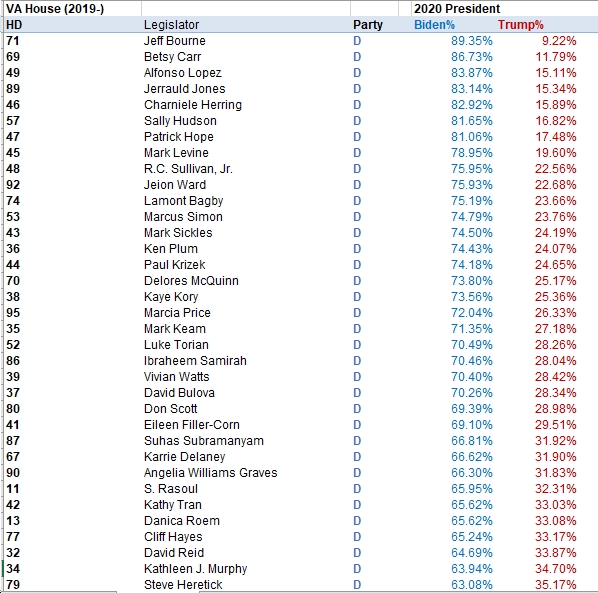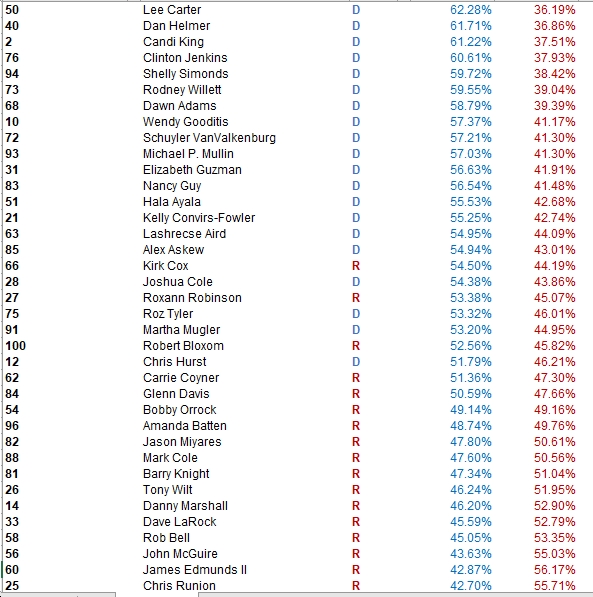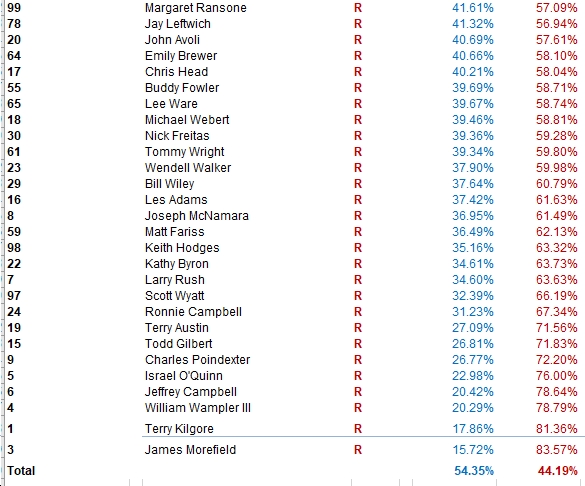Back in early March, we posted about excellent work by Ohio-based cartographer Ryan Brune, who undertook the challenging job of allocating absentee votes by precinct and calculating a district-by-district breakout for the November 2020 election results in each of the 100 Virginia House of Delegates districts. What Brune found was:
- Joe Biden appears to have won 61 out of 100 House of Delegates districts.
- The six Republican-held seats that Biden carried in November 2020 are HD27 (currently held by Republican Del. Roxann Robinson), HD62 (currently held by Republican Del. Carrie Coyner), HD66 (currently held by Republican Del. Kirk Cox, who is running for governor), HD81 (currently held by Republican Del. Barry Knight), HD84 (currently held by Republican Del. Glenn Davis, who is running for LG), HD100 (currently held by Republican Del. Rob Bloxom).
For the methodology that Brune used, click here. In short:
- “We know the demographic profile of Virginia precincts, the building blocks of legislative seats. A useful tool in this instance was Dave’s Redistricting App, and I was able to leverage these known demographic quantities to refine my estimates (displayed in the table at the conclusion of this piece). Precinct analysis from other states (where available) has suggested that Joe Biden made great gains among college educated Whites, more or less held steady among Whites without a college degree, slightly fell with African Americans, moderately declined with Asian Americans, and had a steep decline with Hispanic voters compared to Clinton in 2016. In his 2020 election autopsy, former Obama campaign alumnus David Shor provides detailed estimates for these groups– I cannot recommend it highly enough.”
Now, we have another estimate, from a different group of analysts – the Daily Kos Elections team – and it matches up very well with Brune’s analysis. Here are a few highlights from the Daily Kos calculations:
- “Joe Biden won 60 districts—the same number as outgoing Democratic Gov. Ralph Northam carried based on his 2017 performance, though the overlap wasn’t perfect.”
- ” Among the top protection targets is second-term Del. Chris Hurst, whose HD-12 in the southwestern part of the state is the least-blue among Democrats, having backed Biden 52-46.”
- “Other similarly situated newer lawmakers include Martha Mugler (HD-91), Joshua Cole (HD-28), Alex Askew (HD-85), and Kelly Convirs Fowler (HD-21), Elizabeth Guzman (HD-31), and Nancy Guy (HD-83), all of whose seats backed Biden by margins of 15% or less. Many of the districts that will be most heavily contested this year are in the Virginia Beach region on the southeastern shore of the state, an area with a large military presence, including Mugler’s, Askew’s, and Guy’s.”
- “One rare longtime legislator under threat is Del. Roz Tyler, whose HD-75 in the Southside region along the North Carolina border is one of just 11 in the whole state that got redder on the presidential level between 2016 and 2020, voting for Hillary Clinton 54-44 but Biden by a narrower 53-46. (Clinton, incidentally, won 56 seats overall.)”
- ” HD-84 in Virginia Beach, which is represented by Republican Del. Glenn Davis, who’s running for lieutenant governor. Davis’ district backed Biden 51-48 but is moving in the right direction for Democrats, since it went for Donald Trump 49-45 four years earlier.”
- “The lone seat that Biden carried but that Northam did not is HD-62, also in the Richmond area: Republican Ed Gillespie won it 51-48 in the 2017 governor’s race but Biden prevailed 51-47 last year. That trend could entice Democrats to target Republican Del. Carrie Coyner. The one district that went in the other direction was HD-81 in Virginia Beach, represented by Republican Del. Barry Knight. Northam won it 52-47 but Trump carried it 51-47.”
By the way, I strongly agree with the Daily Kos folks that we shouldn’t look at these numbers and get overconfident in any way/shape/form. Because, for those of us who have been following Virginia politics for a few years, particularly those of us who were around during the “before times” (pre-Trump, that is), historically Virginia Democratic voters tended to not turn out in large numbers in non-presidential/non-federal-election years, which is why Republicans held 66 out of 100 House of Delegates seats prior to the November 2017 elections – even though Virginia had gone for Democrats Mark Warner in 2001, Tim Kaine in 2005, Jim Webb in 2006, Barack Obama in 2008 and 2012, Tim Kaine in 2012, Terry McAuliffe/Ralph Northam/Mark Herring in 2013, Mark Warner in 2014 (albeit barely), Hillary Clinton in 2016, etc. That’s also why localities like Prince William County and Loudoun County could go “blue” during presidential and federal elections, but then elect heavily Republican Boards of Supervisors, as well as heavily Republican General Assembly delegations, in odd-year elections. All of that’s why, as the Daily Kos folks explain:
“However, it’s Republicans who are on offense this year. After two straight cycles of gains, Democrats simply have more districts to defend, particularly because off-year turnout is likely to revert to form. During the Trump era, energized progressives found new reasons to donate, volunteer, and vote, but maintaining that enthusiasm now that Democrats enjoy majorities both in D.C. and Richmond will almost certainly be harder.
Those off-year electorates had often been unkind to Team Blue downballot in the Old Dominion, which is why Biden’s performance shouldn’t be taken as a definitive benchmark.”
So yeah, the big question post-Trump is whether or not Democrats stay active and engaged. The threats to our democracy have certainly not disappeared; if anything, they’ve gotten even worse, as the Republican Party continues to radicalize against democracy and to purge its few remaining pro-democracy members, like Rep. Liz Cheney. And Republicans will certainly be energized with Joe Biden in the White House, and with their delusional/”big lie” beliefs about the election supposedly being “stolen,” about Democrats supposedly moving the country towards “socialism,” blah blah blah. As for Democrats, right now I’m not feeling the same energy/enthusiasm I felt during 2017 at this time, or 2019 at this time for that matter. Is that because of COVID-19 and the relative lack of in-person events for Democrats (note: Republicans don’t give a crap about COVID, and have been campaigning for a while now in person, without masks or social distancing, because that’s how they roll)? Or is it because of post-Trump “exhaustion” (and/or complacency) by Democratic voters?
The bottom line, for the reasons noted above, is that we have to *assume* that Republicans will turn out in large numbers this November, and make sure we respond accordingly. If not, then the fact that Joe Biden won 60 or 61 House of Delegates seats in November 2020 will be completely irrelevant, as will the fact that Republicans haven’t won a statewide race in Virginia since 2009. Because, in the end, if Democrats show up to vote (and volunteer), we’ll stand an excellent chance of winning this November, but if Democrats do NOT show up, then it’s not beyond the realm of possibility that Republicans could win back the House of Delegates and possibly even statewide offices. Let’s all make damn sure that doesn’t happen!
P.S. See below for the results, sorted from highest to lowest Biden %, for all 100 Virginia House of Delegates districts. So which districts do we need to be most concerned about? Based on this analysis: Del. Chris Hurst (D-HD12), Del. Martha Mugler (D-HD91), Del. Roz Tyler (D-HD75), Del. Joshua Cole (D-HD28), Del. Alex Askew (D-HD85), Del. Lashrecse Aird (D-HD63), and possibly several more.







![Saturday News: “Trump’s latest tariff TACO probably won’t make your life more affordable”; “The Epstein Email Cache: 2,300 Messages, Many of Which Mention Trump”; “[MTG] questions if Trump is still the ‘America First’ president”; “Jim Ryan tells all: ‘What did the Governor know, when did he know it?’”](https://bluevirginia.us/wp-content/uploads/2025/11/montage1115-238x178.jpg)







![Saturday News: “Trump’s latest tariff TACO probably won’t make your life more affordable”; “The Epstein Email Cache: 2,300 Messages, Many of Which Mention Trump”; “[MTG] questions if Trump is still the ‘America First’ president”; “Jim Ryan tells all: ‘What did the Governor know, when did he know it?’”](https://bluevirginia.us/wp-content/uploads/2025/11/montage1115-100x75.jpg)
